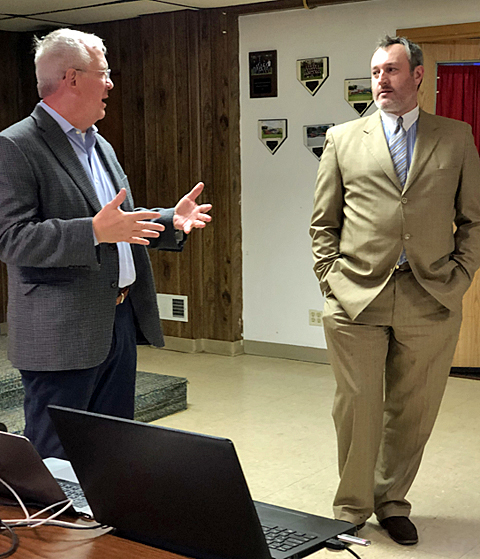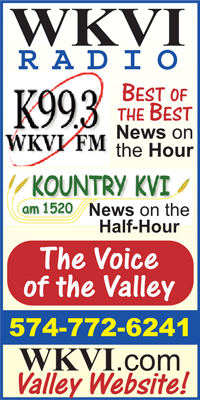The local economic summit, organized by the Pulaski County Economic Development Commission, has been on hiatus the past two years due to the pandemic. The evening began with a catered meal prepared by the American Legion Auxiliary, and desserts made by Main Street Bakery in Medaryville.
Hicks provided abundant statistics and research, past and present, on why population and businesses locate where they do, what works and doesn’t work with state and local government policies for business/industry, and an observation on low taxes vs. necessary taxes.
Hicks is the director of the Center for Business and Economic Research and the George and Frances Ball Distinguished Professor of Economics in the Miller College of Business at Ball State University. He is also well-known to many for his articles on economic matters in statewide newspapers and other publications.
Dr. Hicks: ‘Schools, safety, health’
 |
| Economics and business research professor Dr. Michael Hicks of Ball State University (left) and Pulaski County CDC executive director Nathan Origer visit before the 2022 Pulaski County Economic Development Summit in Medaryville. |
Prof. Hicks noted he and fellow researchers have conducted extensive studies on why people live where they live, and businesses locate where they do.
“What in today’s economy cause them to live where they live? Most (local governments) want more people and businesses,” he continued, asking the critical question, what incentives lure them to a location?
Beaches, lakes, mountains and temperate climates and other such natural amenities help, but don’t top the list.
Hicks reported that research reveals quality of life issues drive these choices – most important of which are well-funded public schools, low crime rates and a healthy environment as measured in resident average health. He said the price people are willing to pay for homes and the wages they will accept depend on the amenities of the community.
A self-described “Reagan conservative,” Hicks acknowledged that low taxes do not rank high on factors that attract population or business. “If low taxes mattered, no family or business would move to Carmel, Fishers, Westfield or Zionsville,” he has written. Or to San Francisco (or most locations in California), or other high growth and taxed areas in the nation as he told the group assembled for the local summit in Medaryville.
This affirms what Hicks has also written from his research: “residents naturally will pay more for a home in a nice place and accept slightly discounted wages to live where they prefer. This builds a self-reinforcing and virtuous cycle where local governments have more tax dollars available to spend on amenities, while businesses face lower labor costs. That’s why these places grow.”
Hicks said in the last 30 years, 80 percent of job growth has gone to college graduates, and the rest to those with some post-high school training. He added these workers understand and are able to operate in today’s mobile job and housing markets. He recommended that elected officials and community development directors should seek well-educated, well-compensated workers employed in high-tech fields to grow their communities.
In recent years, Hicks pointed out that every community development director has wanted to “attract an Amazon warehouse with 500 jobs.” Tax and incentive packages have been developed to facilitate these goals. But such efforts have not always grown local economies.
Looking back through history, he noted that in the past 50 years the U.S. has been a “job creating machine,” especially with the addition of women into the workforce beginning in the 1970s and 1980s.
Manufacturing employment in the Midwest peaked in the 1960s, Hicks said. It is widely regarded that incentives offered by southern states in the years that followed drew those jobs away. (“Or was it air-conditioning?” Hicks pondered.) So when did manufacturing production peak in the U.S.? 1928? 1945? Actually, it was last year, Hicks said. And, also the year before that. “The U.S. is making more stuff than ever before,” he quipped. “But with fewer people.” That’s thanks to more technology and automation and greater efficiency. The same is true in other fields, such as agriculture.
Hicks made mention of Pulaski County’s consideration of solar energy production development. He made no recommendation on what county officials should decide, but noted that “whatever you do, you will be making trade-offs.”
Throughout his presentation, Hicks noted that securing jobs and attracting workers is usually the proverbial “chicken-and-egg” dilemma. “Which comes first? Attracting jobs or attracting population?”
Whatever the answer, he emphasized the need for community leaders to consider quality of life issues, the amenities that will attract both employers and employees. It begins with quality public schools, public safety and a healthy environment.
Origer: ‘State of Pulaski County Economy’
Report given by CDC executive director Nathan Origer
The last time I gave one of these talks, Joe Maddon was still managing in Chicago. Then the world turned upside down, and, along with it, the Cubs. But I’m not here to talk about baseball, or why the universal designated hitter is an undeniable sign of societal collapse. I’m here to talk about the Pulaski County economy, which, kind of like the Cubs, is in something of a rebuild that we’re not calling a rebuild — only partially, though: just as the opening series against the Brewers went better than expected, while I did my best Eeyore impersonation three years ago, we’re in much better shape than we could be.
Not even lockdowns, a worldwide work-from-home experiment, and a toilet-paper shortage could stop Pulaski County from committing to building a stronger future in 2020. The Board of Commissioners green-lighted renovating and adding on to our Justice Center and comprehensively rehabilitating our historic courthouse; the County Council took significant action to stabilize our finances while lowering our income-tax rate; and Mammoth Solar came knocking — and we answered, even if it’s been a drawn-out, complicated welcome for this guest.
Justice Center/Courthouse Projects
Though they’re seemingly the least relevant to economic development, I want to speak first about these public-works projects. We’re two months out from completion of justice-center construction; moving the Circuit Court to the same building as the jail is going to improve public safety, while housing both Courts, the Prosecutor’s Office, and Probation in the same building could create new operational efficiencies.
Without relocating the Circuit Court, the courthouse project, slated to start late this year, would be significantly more complicated than it’s already proving to be — and probably less impactful.
Perhaps most exciting is that, even though it’s going to happen as a separate undertaking after our contractors have handed the addition over to us, the construction of a work-release dormitory in the justice-center basement is targeted for this summer, a project the passion for which was reignited by the progress that we’ve made with our two core buildings. This facility will allow us to build stronger relationships between our criminal-justice system and our major employers, whose workforce struggles have only been exacerbated over the last two years, while helping qualified inmates to get their lives back on track to contribute to their own well-being, their families’, and the community’s.
The courthouse project has been a bit more contentious than the justice-center addition, but there is great value in it — value beyond the cost savings compared to building a new structure. Historic preservation is economic development, especially when the preservation is taking place in the heart of downtown — a downtown we hope will see new vibrancy as we yet again work to establish a Main Street organization in Winamac, our beloved WOW! having proven to be a bit too star-crossed for this life. The new space in the upper level created by the relocation of the Circuit Court and the lower-level space made habitable again will get us nearer to vacating the east annex, which not only is poorly laid-out for governmental purposes, but is too perfectly located to be wasted on county offices. The lovely homes of Riverside Drive, our fantastic library, and the river and adjacent town park could make it such a great location for a mixed-use redevelopment right off of downtown put back on the property-tax rolls — maybe a small restaurant where the Extension offices are, with outdoor seating overlooking the Tippecanoe, a microbrewing facility in the old museum, and a few apartments or boutique-hotel rooms upstairs. The options are voluminous, but nonexistent until we move our departments out of there and get the building into the private sector.
Tax Adjustments
If you’re a rational person, you’re probably wondering how the economic-development director ended up coordinating multimillion-dollar public-works projects for the County. Even if you’re irrational, you still might ponder this scenario. Long story short: it all started with income taxes.
You probably know that until last year, we not only had the highest county tax rate in Indiana, but that it was high enough to exceed the state’s rate, meaning that Pulaski County’s income earners sent more of their paychecks to the courthouse than to Indianapolis. What you might not realize is that 35 percent of that 3.38-percent rate was not funding county operations directly, but reducing everyone’s property-tax liabilities. You can agree or disagree with this mechanism; you can call it ‘subsidy,’ ‘welfare,’ or its official name — ‘property-tax replacement credit.’ Any way you slice it, it’s hard to justify pilfering paychecks to that degree just to offset property-tax bills, especially when income-taxpayers live in and contribute to our community, but many property owners don’t, and we already had a long-time levy freeze in place keeping property taxes in check. It’s also hard to explain to major employers that we voluntarily adopted a policy that discourages people from residing here, thereby amplifying their workforce-attraction and –retention difficulties.
What began, almost quixotically, in 2015, when a then-elected official berated me in the middle of a county-council meeting for daring to suggest that we shift some of our revenue burden from wage earners to property; involved two different accounting consultants over two years; and led to my knowing far more about how local taxes work in Indiana than I ever imagined culminated in late 2020 with the Council’s thawing our levy freeze and approving a 15.7-percent reduction to the income tax, down to 2.85 percent — perhaps still higher than ideal, but no longer the state’s highest. It also opened the floodgates to my being asked to take on more and more responsibilities that stretch the boundaries of my job description; thus the construction projects, which, don’t get me wrong, have been an incredible opportunity for broadening my horizons.
That 0.53–percentage-point rate reduction actually managed to increase our annual revenues, since we cut our subsidy rate while increasing our expenditure rate, putting us on a slow, but steady path toward financial stability. Being more attractive to residents while improving fiscal health: what a concept! In my 2019 address, I dispiritedly reported that the county would be looking at an annual operating deficit of about $2.5-million if something significant didn’t change. Something significant did change.
Our bank account is still a little weak, and we need to make careful and wise fiscal choices that sustain our operations and protect our savings while investing in a stronger future, but we’re headed in the right direction.
Solar Energy
I guess you could say that the sun in finally starting to shine on Pulaski County.
The journey from first connection to power generation has been slow and sometimes shocking, and we still haven’t completed the circuit, but solar energy in Pulaski County has the potential to be a bigger game-changer than a 17-minute rain delay in Cleveland was in November 2016.
If the two currently proposed projects move forward as intended, then, pursuant to the adopted economic-development agreements, Pulaski County will be able to start paying the annual debt service on both public-works projects without a special tax levy and still have between $1.2- and $1.6-million in discretionary revenue each year to fill the piggy bank, to improve employee retention, and to invest in the community’s future — all while the increased land assessment softens annual levy-growth impacts on property-tax bills. (Alternatively, we could reduce that extra revenue to between $300,000 and $700,000 for the first decade while setting enough aside to pay off the complete debt service after year 10, saving the county significant interest payments.)
A charming conman once remarked that a town with money’s a little like the mule with a spinning wheel: no one knows how he got it, and danged if he knows how to use it. Ultimately, allocation of this revenue will be at the discretion of the Council, but it feels almost more like kismet than coincidence that as these developers were starting to eye Pulaski County, the CDC began contemplating an update to our strategic plan, and our friends at the Community Foundation, spurred by funding from the Lilly Endowment, launched their Forward Thinking Leadership initiative, one outgrowth of which is their Aspirations-in-Action community-development programming, where they’re focusing on the aforementioned Main Street Winamac revival, broadband development, and housing, all of which can be found in the 2021 update to our strategic plan, “Simply Pulaski: a Plan for Quality.”
Now, this county may not be well-suited for a monorail, but this revenue could help to improve connectivity, housing stock, downtown development, and public or semi-public transportation that could open up new opportunities for our employers to attract and to retain employees. It could be used to invest in programs or facility upgrades at our schools and libraries. We could spare our tax-based funds while ensuring that we have enough staff to implement our strategic plan conscientiously, thoroughly, and vigorously. Perhaps we could allocate some of it toward workforce-training programs — whether for the incumbent workforce, high-school students and recent graduates, or the residents of the planned work-release dormitory — or programming to encourage entrepreneurship. What kind of quality-of-life amenities could we support? Maybe we could finally connect the Panhandle Pathway to the state park and beyond, getting us that much closer to being part of a multi-regional, long-distance trail. Some of the revenue might be best used as local match for grant funding to maximize our value for eligible programs and projects. We can’t get ahead of ourselves before the money starts flowing, and the Council has the final say, but the extent to which we could wisely invest in our community to build our Mayberry 2.0 is awe-inspiring.
Addressing Challenges
All of this optimism, however, is not meant to suggest that the local economy is not without its weaknesses or threats. We learned that our population dropped by 888 from the 2010 Census to 2020, almost 90 per year. The only age cohort where we saw a population increase over the decade is the 65-and-up group, an encouraging sign if we’re hoping to become the home of the Midwest Shuffleboard Championship, but less thrilling if we want to maintain the robust workforce required to sustain investment in our community. Our retired and semi-retired residents make for incredible volunteers and elected officials, but it takes more than that to keep our economy buzzing and our community thriving. We need to be able to keep and to attract Millennials and even TikTok-ing, mom-jeans–loving Zoomers.
In December, I polled our local manufacturers and received feedback from nine of them; they reported almost 90 vacancies just in production. That’s more people than who circulated through the record-breaking 2021 Cubs roster. Our local companies continue to work with us and other partners, to improve themselves as employers, and to leave no note silent in search of a cure for the workforce blues, but this is as much our community’s problem as it is our employers.’ This is why we have to invest in ourselves.
This is why the CDC overhauled much of our previous strategic plan and why we need to be diligent in implementing the update. Employers have to work to make themselves preferred workplaces; Pulaski County needs to work to make itself a preferred place to call home. I suspect that this evening’s guest speaker will have something to say about that.
Community development is a team sport, and all of Pulaski County is in the lineup. Our strategic plan is our playbook for a vibrant, sustainable, healthier, and wealthier Pulaski County; we can only go so far in implementing it without the active engagement of our wonderful partners, like the Community Foundation, major employers, and our county and town governments. We can only go so far in implementing it without the active engagement and support of the members of this wonderful community. Thank you.







